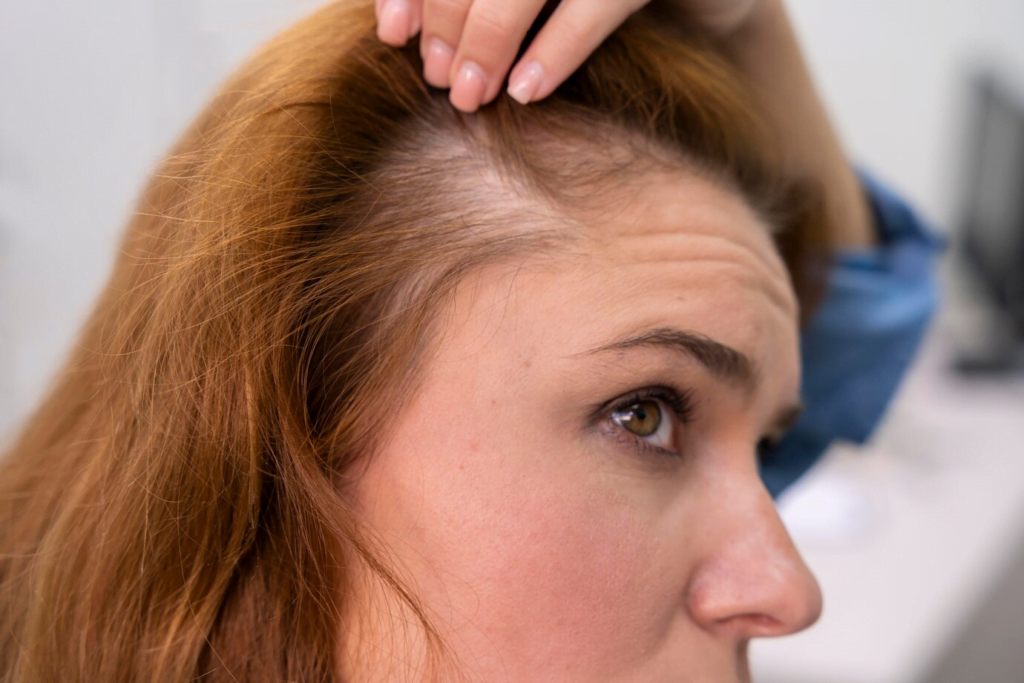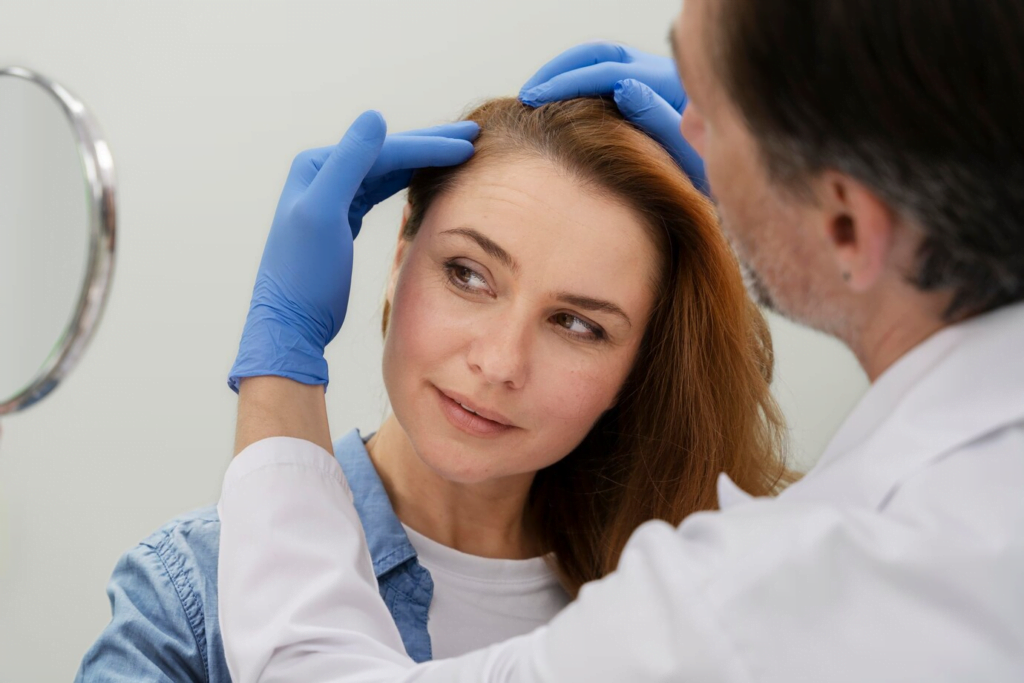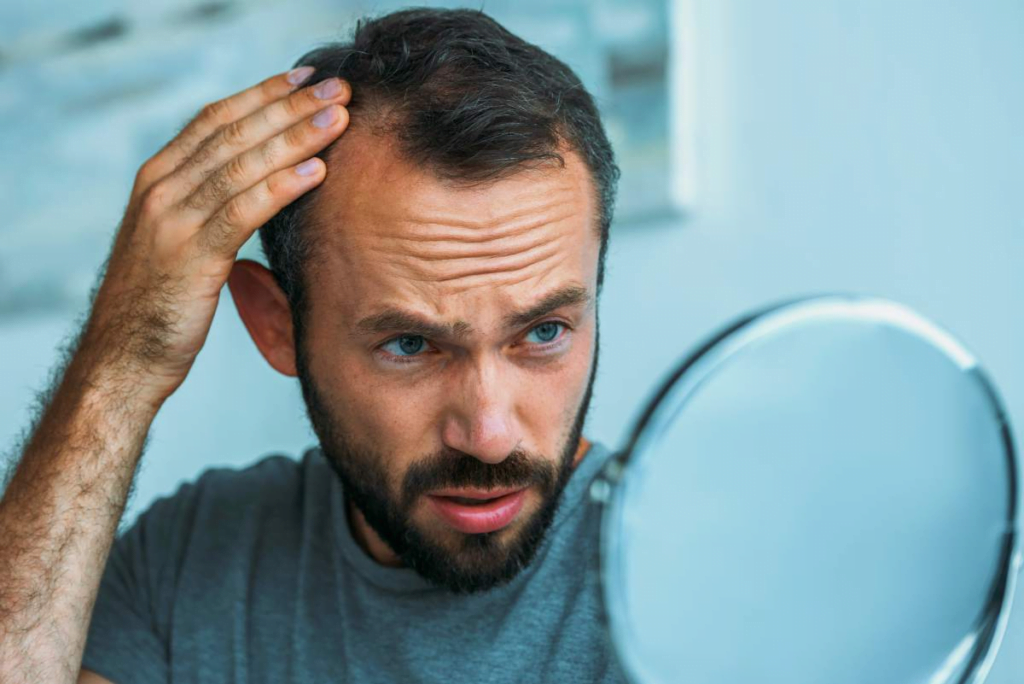What Hair Transplant Technique is Best for FFS? Have you ever looked in the mirror and longed for a more balanced, feminine hairline? Facial Feminization Surgery (FFS) can be a transformative procedure, but achieving a truly natural look often requires addressing the hairline as well. So, the question arises: when it comes to FFS, what hair transplant technique reigns supreme?
This guide dives deep into the world of hair transplantation for FFS, exploring the two main contenders – Follicular Unit Strip Surgery (FUSS) and Follicular Unit Extraction (FUE) – to help you discover the best hair transplant technique for FFS that aligns with your unique goals.

İçindekiler
Unveiling the Best Hair Transplant Technique for FFS: A Comprehensive Guide
The pursuit of a balanced, feminine hairline is a common desire for many considering Facial Feminization Surgery (FFS). While FFS works wonders in reshaping facial features, achieving a truly harmonious look often necessitates addressing the hairline as well. But with various hair restoration techniques available, the question lingers: what reigns supreme as the best hair transplant technique for FFS?
This in-depth guide delves into the world of hair transplantation for FFS, dissecting the two primary contenders – Follicular Unit Extraction (FUE) and Follicular Unit Strip Surgery (FUSS) – to empower you in discovering the best hair transplant technique for FFS that aligns with your individual goals.

Is FUE or FUT better for hair transplants with FFS?
The debate between FUE and FUSS as the best hair transplant technique for FFS hinges on several factors. Let’s break down each technique:
- FUE hair transplant (Follicular Unit Extraction): This minimally invasive technique involves extracting individual follicular units directly from the scalp using a specialized punch tool. FUE leaves minimal scarring, making it a popular choice for those seeking a discreet approach.
- FUSS hair transplant (Follicular Unit Strip Surgery): This technique involves removing a thin strip of scalp containing healthy hair follicles. These follicles are then dissected into individual follicular units for transplantation. While FUSS allows for a larger number of grafts to be harvested in one session, it leaves a linear scar at the donor site.
Does hair transplant technique affect FFS results?
Absolutely! The best hair transplant technique for FFS can significantly impact your final results. Here’s how:
- Hairline design: A crucial aspect of FFS is achieving a natural-looking, feminized hairline. Both FUE and FUSS can be used to create a soft, rounded hairline with a lower positioning compared to a typical male hairline.
- Donor area quality: The quality and quantity of donor hair follicles are paramount. A skilled surgeon will assess your scalp to determine the best hair transplant technique for FFS based on your donor area characteristics.
- Scarring: While both techniques can achieve excellent results, FUE generally leaves minimal scarring, which is particularly desirable for FFS patients seeking a seamless transition.

When to get a hair transplant before or after FFS?
The timing of your hair transplant relative to FFS depends on your individual circumstances. Here are some considerations:
- Hairline lowering: If FFS involves hairline lowering surgery (sometimes referred to as scalp masculinization surgery), a hair transplant might be recommended afterward to camouflage any potential scarring and achieve optimal hairline density.
- Hairline advancement: Conversely, if your FFS goals involve hairline advancement (also known as female hair transplant or feminizing hairline), a hair transplant might be performed beforehand to establish the foundation for the new hairline position.
Ultimately, a thorough consultation with an experienced FFS surgeon who is also adept at hair transplantation is crucial to determine the optimal timeline for your procedures.
Are there hair transplant techniques specifically for FFS?
While FUE and FUSS are not techniques exclusive to FFS, experienced surgeons specializing in FFS understand the nuances of creating a natural-looking feminine hairline. They utilize these techniques with a specific focus on:
- Natural hairline design: Replicating the softness, roundness, and appropriate positioning of a feminine hairline.
- Angulation and direction of hair growth: Mimicking the natural growth patterns of female hair for a realistic appearance.
- Density variation: Creating a natural density gradient with a slightly higher density at the forefront of the hairline and a gradual decrease towards the temples.

What are the risks of hair transplants for FFS?
As with any surgery, hair transplants for FFS carry some potential risks, though these are generally minimal when performed by a qualified surgeon. These potential risks include:
- Infection: Proper sterile technique and post-operative care can significantly minimize this risk.
- Scarring: While FUE minimizes scarring, there’s always a slight possibility of scarring at the donor and recipient sites.
- Bleeding: Bleeding is typically minimal and controlled by the surgeon during the procedure.
- Unnatural-looking hairline: This highlights the importance of choosing a surgeon with expertise in FFS hair transplantation.
How much does a hair transplant cost for FFS?
The cost of a hair transplant for FFS can vary depending on several factors, including:
- Surgeon’s experience and qualifications: Surgeons with specialized training in FFS and hair transplantation typically command higher fees.
- Geographic location: Costs can vary depending on the surgeon’s location and the overall cost of living in the area.
- Number of grafts needed: The number of grafts required to achieve the desired hairline density will significantly impact the cost.
- Technique used (FUE vs. FUSS): While both techniques can achieve excellent results, FUE generally comes with a slightly higher price tag due to the time-intensive nature of graft extraction.
It’s important to prioritize choosing a qualified surgeon over cost alone. A consultation with an experienced FFS surgeon can provide a more accurate estimate of the cost based on your individual needs.

Can hair transplants create a natural-looking feminine hairline?
Absolutely! When performed by a skilled surgeon specializing in FFS hair transplantation, hair transplants can create a natural-looking, feminine hairline. Here’s how:
- Meticulous planning: The surgeon will meticulously plan the hairline design, considering factors like facial proportions, desired hairline shape, and natural hair growth patterns.
- Follicular unit selection: Healthy follicular units with multiple hairs are chosen for transplantation in the frontal hairline area for optimal density and a natural appearance.
- Angulation and direction: Careful attention is paid to replicating the natural angulation and direction of hair growth for a realistic outcome.
Are there any alternatives to hair transplants for FFS?
While hair transplants are a highly effective method for achieving a natural-looking feminine hairline, there might be alternative options to consider depending on your individual circumstances. Here are two possibilities:
- Scalp micropigmentation: This non-surgical technique involves tattooing tiny dots on the scalp to create the illusion of hair follicles. It can be a good option for those with minimal hair loss or who are hesitant to undergo surgery.
- Hairline lowering surgery (scalp advancement): This surgical procedure involves removing a strip of scalp tissue from the forehead area to advance the hairline position. However, it can leave a noticeable scar, making it a less preferred option for many FFS patients.
What qualifications should an FFS surgeon have for hair transplants?
Choosing a qualified surgeon is paramount for achieving optimal results and minimizing risks associated with hair transplants for FFS. Here are some key qualifications to look for:
- Board certification in facial plastic surgery or otolaryngology: This ensures the surgeon has the necessary expertise in facial anatomy and surgical techniques.
- Experience in FFS: Look for a surgeon who has a proven track record of performing successful FFS procedures, including hair transplantation.
- Focus on natural-looking feminine hairlines: The surgeon should have a strong understanding of designing and creating hairlines that complement feminine facial features.
- Positive patient reviews and testimonials: Research online reviews and patient experiences to gain insights into the surgeon’s skills and bedside manner.

How long does hair transplant recovery take after FFS?
Hair transplant recovery after FFS typically takes around 10-14 days. Here’s a general timeline:
- Immediately following the procedure: You might experience some swelling and discomfort, which can be managed with medication.
- First few days: Scalp scabbing is normal and will gradually resolve on its own.
- 1-2 weeks: Most of the scabbing should be gone, and you can resume most daily activities.
- Several weeks to months: New hair growth will begin to appear, and the final results can take up to a year to fully emerge.
Following the surgeon’s post-operative instructions diligently is crucial for optimal healing and successful hair transplant outcomes.
By carefully considering the factors discussed in this guide, you can make an informed decision about the best hair transplant technique for FFS to achieve your desired results and embark on your journey towards a more confident and harmonious you.

Unveiling the Perfect Match: Your Guide to the Best Hair Transplant Technique for FFS
The pursuit of a balanced, feminine hairline can significantly enhance the overall outcome of Facial Feminization Surgery (FFS). While both FUE and FUSS are effective hair restoration techniques, the best hair transplant technique for FFS depends on your individual goals, hair characteristics, and desired recovery timeline.
This comprehensive guide has equipped you with the knowledge to navigate the world of hair transplantation for FFS. We’ve explored the key considerations, potential risks, and recovery process to empower you to make informed decisions.
Remember, achieving a natural-looking, feminine hairline requires expertise. Choosing a qualified FFS surgeon with experience in hair transplantation is paramount for optimal results. Don’t hesitate to schedule consultations with multiple surgeons to discuss your unique needs and ask questions to find the perfect match for your journey.
Embrace the opportunity to unlock your confidence and achieve a truly harmonious look. Take the first step today by scheduling a consultation with an FFS surgeon to explore the best hair transplant technique for FFS and embark on your transformative journey.
Hairtrans.com was founded by world-famous plastic surgeon Dr. MFO, who is an expert in facial feminization or facial masculinization surgeries, and is managed under his leadership. Would you like to have a hair transplant under the coordination of a plastic surgeon with many years of experience?
Whether you are a trans woman or a natural born male or female, if you are looking for the best hair transplant, contact us now.
FAQ
1. Is there a single best hair transplant technique for FFS?
No, the best hair transplant technique for FFS depends on various factors like your hair characteristics, desired outcome, and surgeon’s expertise. Both FUE and FUSS can achieve excellent results, but a consultation with a qualified surgeon is crucial for determining the optimal approach for you.
2. I have heard of FUT, is that the same as the best hair transplant technique for FFS?
FUT stands for Follicular Unit Strip Surgery. While effective, it’s not necessarily the best hair transplant technique for FFS. FUE (Follicular Unit Extraction) is often preferred for FFS due to minimal scarring, which is a desirable quality for many patients.
3. I’m worried about scarring after a hair transplant for FFS. What’s the best hair transplant technique for FFS to minimize scarring?
FUE (Follicular Unit Extraction) is generally considered the best hair transplant technique for FFS when minimizing scarring is a priority. FUE involves extracting individual follicular units, leaving minimal scarring at the donor site compared to the strip scar left behind by FUT.
4. Should I get a hair transplant before or after FFS surgery?
The timing of your hair transplant relative to FFS depends on your goals. If your FFS involves hairline lowering, a hair transplant might be recommended afterward. Conversely, for hairline advancement, a transplant might be done beforehand. Consult an experienced FFS surgeon to determine the optimal timeline for you.
5. Are there any techniques specifically designed as the best hair transplant technique for FFS?
While FUE and FUSS are not exclusive to FFS, experienced FFS surgeons utilize these techniques with a focus on creating a natural-looking feminine hairline. This includes replicating the softness, roundness, and appropriate positioning for a harmonious outcome.
6. What are the risks associated with the best hair transplant technique for FFS?
The risks of hair transplants for FFS are generally minimal when performed by a qualified surgeon. Potential risks include infection, scarring, bleeding, and an unnatural-looking hairline. Choosing an experienced FFS surgeon with expertise in hair transplantation helps significantly minimize these risks.
7. How much does the best hair transplant technique for FFS typically cost?
The cost of a hair transplant for FFS can vary depending on several factors, including surgeon’s experience, geographic location, and the number of grafts needed. Consultation with an FFS surgeon specializing in hair transplantation can provide a more accurate estimate for your individual needs.
8. Can hair transplants create a completely new hairline for FFS?
Absolutely! When performed by a skilled surgeon, the best hair transplant technique for FFS can create a natural-looking, feminine hairline. Careful planning, meticulous follicular unit selection, and attention to detail in angulation and direction are crucial for achieving a realistic outcome.
9. Are there any non-surgical alternatives to the best hair transplant technique for FFS?
Scalp micropigmentation is a non-surgical option that might be suitable for those with minimal hair loss or hesitant about surgery. It involves tattooing tiny dots to mimic hair follicles. However, it doesn’t involve actual hair growth and requires touch-up procedures over time.
10. What qualifications should I look for in a surgeon offering the best hair transplant technique for FFS?
Board certification in facial plastic surgery or otolaryngology is essential. Look for a surgeon with proven experience in FFS procedures, including hair transplantation. Their portfolio should showcase expertise in creating natural-looking feminine hairlines. Positive patient reviews and testimonials are valuable resources as well.
11. How long does recovery take after getting the best hair transplant technique for FFS?
Hair transplant recovery after FFS typically takes around 10-14 days. You might experience some initial swelling and discomfort, followed by scabbing that gradually resolves within the first week or two. Most daily activities can resume within a week, with full hair growth taking up to a year to emerge. Diligently following your surgeon’s post-operative instructions is crucial for optimal healing.
12. Will I experience any hair loss after the best hair transplant technique for FFS?
It’s normal to experience some temporary shedding of transplanted hair in the first few weeks. This is part of the natural hair growth cycle, and the transplanted hair will eventually regrow permanently.
13. Can I exercise after getting the best hair transplant technique for FFS?
Strenuous exercise should be avoided for the first week or two after a hair transplant for FFS to allow for proper healing and minimize the risk of dislodging the transplanted follicles. Light activity like walking is generally okay, but always consult your surgeon for specific guidelines.
14. What should I do to maintain the results of the best hair transplant technique for FFS?
Maintaining a healthy lifestyle with a balanced diet rich in essential nutrients is beneficial for overall hair health, including transplanted hair. Gentle hair care practices and sun protection for the scalp are also crucial. Consult your surgeon for personalized recommendations.
15. Is it safe to get another hair transplant procedure after the best hair transplant technique for FFS?
Yes, in some cases, additional hair transplant procedures can be performed after the initial one to achieve further density or refine the hairline. However, sufficient time needs to pass for the scalp to fully heal, typically a year or more. Consult your surgeon to determine if additional procedures are suitable for your needs.


